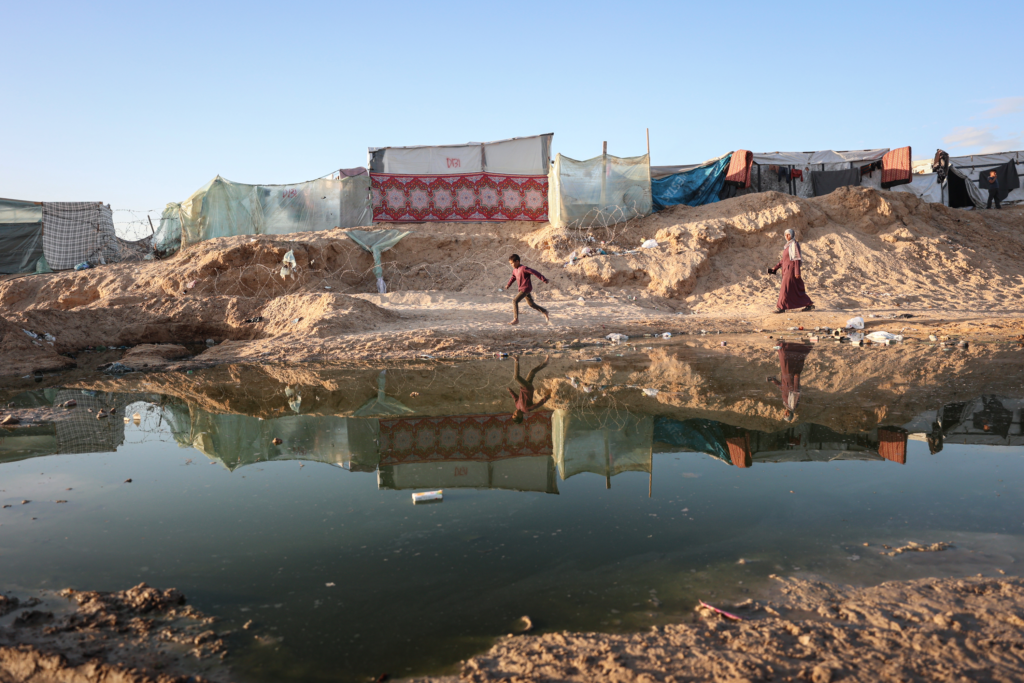As Conflict Rages On, Israel and Gaza’s Environmental Fates May Be Intertwined – Inside Climate News
March 15, 2024
By Kiley Price
Sewage from Gaza is inundating the Mediterranean Sea, and may soon flow into Israel, reports say.

The Israel-Hamas war has claimed the lives of more than 30,000 people. Like all armed conflicts, it has also come with an environmental toll.
From shell casings to Israeli bomb fragments, millions of tons of debris now litter the streets of Gaza, while a blanket of dust and toxic ash permeates the air, posing health risks for individuals across the Strip.
Scientists estimate that more than 281,000 tons of carbon dioxide were generated by Israel’s aerial bombardment and ground invasion of Gaza in the first two months of the war, which is “greater than the annual carbon footprint of more than 20 of the world’s most climate-vulnerable nations,” reports the Guardian.
The United Nations is currently conducting a comprehensive assessment of the environmental impacts from the conflict in Gaza—a slow-going process as fighting continues.
“Human remains are under the building debris, so sensitive management will be critical,” a spokesperson for the United Nations Environment Program (UNEP) told Euronews Green.
One of the most evident and pressing environmental catastrophes unfolding in Gaza surrounds clean water—or lack thereof.
Water and War: Historically, Gaza has secured roughly 90 percent of its water from groundwater wells, namely the Coastal Aquifer Basin, which runs along the eastern Mediterranean coast from Egypt through Gaza and into Israel. But much of this supply is “brackish and contaminated due to seawater intrusion, overextraction, and sewage and chemical infiltration,” writes Natasha Hall, a senior fellow at the D.C.-based think tank Center for Strategic and International Studies (CSIS), and co-authors in a commentary post on the organization’s website.
By mid-October, attacks destroyed desalination plants and cut off access to aquifers in the Gaza Strip, dropping the region’s water production capacity to just 5 percent of typical levels, according to UNICEF. The United Nations estimated late last year that the average individual in Gaza is living on only 3 liters of water per day for drinking, cooking and bathing (for contrast, the average American family uses more than 1,130 liters of water per day at home, according to the EPA).
On top of this, all five of Gaza’s wastewater treatment plants lost powerwithin the first few weeks of the conflict. As a result, sewage has flowed freely through the street, causing a record uptick in cases of diarrheal illnesses, an issue that has only grown worse since I briefly covered it last month.
“Historical marine pollution incidents in Gaza have led to high concentrations of chlorophyll and suspended organic matter in coastal waters, and gastrointestinal parasites: this conflict is likely increasing these issues,” the UNEP spokesperson told Euronews.
Gaza may be facing the brunt of war-related pollution at the moment. However, past evidence shows that Israel’s environmental fate may be closely connected with the territory it is attacking.
Sewage Overflow: Gaza’s sewage infrastructure disaster didn’t happen overnight; years of confrontation between Israel and Hamas have gradually chipped away at this system (Anas Baba and Scott Neumancovered the history of this issue extensively for NPR in December).
In a Tuesday opinion column for the New York Times, Thomas Friedman reflected on a 2018 column he wrote in which he referred to the “third person” in the fight between Israelis and Palestinians: Mother Nature. In the piece, he detailed how Gazans had to discharge rivers of untreated sewage into the Mediterranean Sea—and stressed that this sludge knows no borders.
“Because of the prevailing current, most of that sewage flows northward to the Israeli beach town of Ashkelon, the site of Israel’s second-biggest desalination plant,” Friedman wrote in 2018. “Gaza’s waste is floating into Ashkelon’s desalination plant, and the plant has had to close several times to clean Gaza’s gunk out of its filters.”
History may soon be repeating itself: Without wastewater treatment infrastructure in Gaza, at least 100,000 cubic meters of sewage and wastewater are being discharged on land or into the Mediterranean Sea daily, according to UNEP estimates.
This is “renewing pollution threats to the intake of desalination plants in Israel,” writes Hall and co-authors for CSIS. “All the region’s water and wastewater sources cross into Israel, the West Bank, and Gaza alike. Both populations have an interest in tackling the crisis before it further undermines environmental and public health.”
Though not tied to war, this type of cross-border sewage problem is happening in the U.S., as well. Spanning from Mexico to California before reaching the ocean, the Tijuana River carries millions—sometimes billions—of gallons of untreated wastewater across the border each day. This onslaught commonly overwhelms California’s and, more often, Tijuana’s sewage treatment plants, particularly during storms, an issue I reported on in February.
ttps://insideclimatenews.org/news/15032024/todays-climate-gaza-israel-sewage-environment-debris-pollution/
